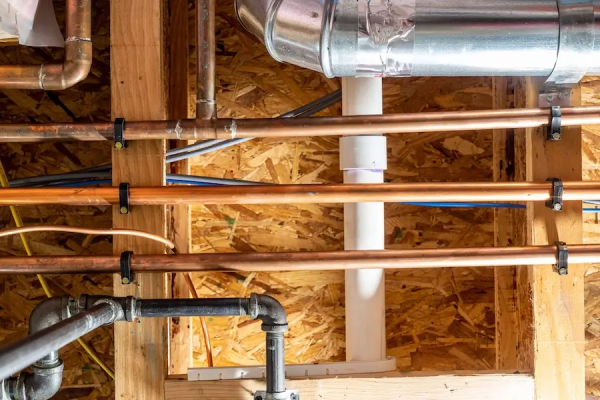
Summary:
Mr. Rooter Plumbing® informs property owners about the different types of plumbing pipes so they can make a decision with confidence.
- PVC and CPVC Pipes: PVC is an affordable, rust-resistant material that is easy to install; however, it is not suitable for hot water applications. CPVC improves on this by tolerating higher temperatures, although it’s only suitable for indoor use and is slightly more costly.
- Copper Pipes: Durable and corrosion-resistant, copper pipes offer excellent water quality and longevity; however, they are expensive and not environmentally friendly due to their intensive manufacturing process.
- PEX Pipes: Flexible, easy to install, and resistant to corrosion, PEX is ideal for indoor plumbing; however, it degrades in sunlight and may affect the taste or smell of the water.
- HDPE and Stainless Steel Pipes: HDPE is leak-resistant and ideal for underground use; stainless steel is corrosion-resistant and strong, but it is also very expensive.
- Cast Iron, Galvanized, Black Iron, and Polybutylene Pipes: These pipe materials were once popular but are now largely replaced due to issues such as rust, lead risks, and leaks.
When performing pipe replacement or installing plumbing systems in a brand-new home, you’ll quickly realize just how many pipe options exist. Some once-commonplace pipe materials are no longer in use, while others are at the cutting edge of innovation and are among the most frequently used.
If the time has come to explore pipe replacement for your property, keep reading to learn about the most common pipe types and whether they’re right for you.
Polyvinyl Chloride Pipes (PVC)
Polyvinyl chloride, commonly referred to as PVC, is a thermoplastic polymer material consisting of both vinyl and plastic. PVC pipes come in a range of colours, including white, gray, and cream, and are a standard option for transporting potable water, main water supply lines, and drainage. PVC pipes are available in various thicknesses and configurations to suit different applications.
There are many benefits associated with PVC pipes, including:
- Longevity: PVC pipes can last longer than steel or copper pipes and are resistant to rust and corrosion.
- Practicality: They are lightweight and easy to transport. Installation is also easy, as you can connect them with glue, rather than having to solder them together.
- Compatible with high pressure: PVC pipes are often used for main supply lines to homes because they can withstand high water pressure.
- Affordability: Compared to other pipe materials, such as copper, PVC pipes are more cost-effective.
However, it’s worth keeping in mind that there are a few drawbacks associated with PVC pipes:
- Limited sizing: There isn’t a massive range of pipe sizes. What’s more, even if you find the most suitable size, the fittings for it can be too bulky.
- Warping: When exposed to heat, PVC can warp and melt. As a result, it’s not suitable for hot water transportation.
Chlorinated Polyvinyl Chloride Pipes (CPVC)
One of the main disadvantages associated with PVC pipes is their limitations with hot water. That’s where chlorinated polyvinyl chloride (CPVC) pipes come in. They contain the same basic elements as PVC pipes, but the polyvinyl chloride materials are chlorinated. As a result, CPVC pipes can withstand more temperature differences.
There are also other advantages associated with CPVC pipes, including:
- Longevity: Just like PVC pipes, CPVC pipes don’t rust or react to corrosive substances.
- Compatible with high pressure: CPVC pipes can handle high water pressure, making them ideal for main water lines.
- Low-cost: CPVC pipes are more affordable than many materials, such as copper, even though they are slightly more expensive than PVC.
- Practicality: CPVC is easy to work with due to its lightweight nature and reasonable flexibility.
- Temperature tolerance: CPVC can work with extreme temperatures up to 93 degrees Celsius (200°F).
Before installing CPVC on your property, it’s essential to be aware of its disadvantages. The most obvious disadvantage of this pipe material is that it’s only suitable for indoor use because it can break down when exposed to sunlight over extended periods. It’s also more expensive than PVC.
Copper Pipes
Copper pipes have been used in plumbing systems for many years and remain popular even today. Two types of copper pipes are commonly used: rigid and flexible.
Rigid or hard copper is common for water supplies in homes and businesses. Plumbers can easily cut and solder copper pipes. Where space is tight and plumbers need more flexibility, they often use soft or flexible copper. It’s common to find flexible copper in corners or faucet supply lines.
Alongside hard and soft copper pipes, plumbers have access to copper pipes of various thicknesses: Type M, Type L, and Type K.
Type M copper pipes are the thinnest available and are typically used for drain, waste, and vent piping. They are ideal for hot and cold supply lines in homes. For transporting drinking water, Type L copper is often the preferred choice. It’s also suitable for interior hot and cold water supplies.
If you need to install pipes in harsh conditions, Type K copper pipes are usually recommended. They have the thickest walls and can be used as underground service lines.
Alongside having a wide variety of options regarding the type of copper pipe you use, there are also many other advantages of using copper pipes, including:
- The material can last 50+ years
- Leak- and corrosion-resistant
- Doesn’t pollute water
- Bacteria don’t thrive in copper
- Can withstand extreme temperature changes
- Recyclable material
There are also some drawbacks:
- Expensive compared to other pipe materials
- Not considered a ‘green’ product due to the environmental impact of the mining and manufacturing processes

Cross-Linked Polyethylene Pipes
Cross-linked polyethylene (PEX) pipes are becoming increasingly popular in new builds. The materials used in these pipes are reasonably new in plumbing, but are proving versatile for several applications.
Unlike PVC pipes, PEX pipes are flexible, allowing for longer runs. They are also easy to cut and join and are designed to last a long time. PEX pipes can be purchased in hard lengths or a flexible roll. There are many standout benefits of using PEX pipes in plumbing systems, including:
- Resistant to rust and corrosion, so they can last indefinitely
- Flexible enough to make a 90-degree turn
- Easy installation without gluing or soldering
- Can withstand extreme temperatures
- Cheaper than copper pipes
However, before installing PEX pipes, be aware of their disadvantages:
- Only suitable for indoor use, as UV radiation can damage the material
- Some people notice changes in the taste and smell of their drinking water
High-Density Polybutylene Pipes (HDPE)
High-density polybutylene (HDPE) pipes are a popular material option for underground service lines and various other plumbing applications. Their robustness and corrosion resistance often make them a preferred choice over PVC in building codes.
As HDPE pipes are flexible, they require fewer joins. Where joins are needed, heat fusion is a standard connection method. As a result, they are far less prone to leaks than other pipe materials.
Stainless Steel Pipes
If you live in a coastal community or another area prone to rust, you may decide to use stainless steel pipes in your plumbing system. Stainless steel pipes are one of the most expensive options, even more so than copper. However, their price is reflective of their quality. They are corrosion-resistant and strong to last the distance. You can also purchase stainless-steel pipes in a variety of sizes and both rigid and flexible types.
Less Common Pipe Materials
If you’re exploring pipe replacement and weighing up the pros and cons of the popular pipe materials above, it’s also worth learning more about the less common materials. Many of these were once commonplace but have since fallen out of favour for a host of reasons.
- Cast iron: Cast iron was commonly used in the first half of the 20th century and is still found in many homes today. It’s strong, heavy, durable, reduces sound, and is heat-resistant. However, cast iron pipes can be susceptible to rust and are often replaced with plastic pipes, such as PVC.
- Galvanized steel: Galvanized steel pipes were once the crème de la crème of pipe materials, used until around the 1980s. They were preferred for their strength and ease of installation. However, they had a short lifespan, were susceptible to rust and corrosion, and could cause lead contamination if they corroded.
- Polybutylene (PB) pipes: PB pipes were common in the 1970s-1990s. Approximately 10 million homes were built with pipes made from a form of PB plastic resin. It was thought that this material would eventually replace copper. However, they stopped being popular because they were prone to leakage around the joins.
- Black iron: Black iron pipes were once a popular choice for water supply lines. Today, they are more commonly used for natural gas, propane, and fire sprinkler systems.
Ask Your Local Mr. Rooter Plumbing® About the Best Pipes for Your Plumbing System
If the time has come to explore pipe replacement, contact your locally owned and operated Mr. Rooter Plumbing® for more information about pipe materials. Our experienced plumbing team can learn more about your needs and suggest the most suitable pipes for the job. Call us day or night or request a job estimate online.

